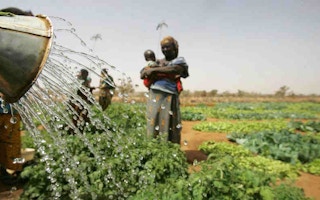FAO and the world’s leading climate-change authority signed an agreement on 21 March allowing both institutions to better serve countries around the world to adapt to and mitigate the impact of warmer global temperatures and meet their pledges to curb greenhouse gas emissions.
FAO Director-General José Graziano da Silva and Patricia Espinosa, Executive Director of the United Nations Framework Convention on Climate Change signed a Memorandum of Understanding that puts a long-lasting partnership on a formal footing.
The accord recognises that “climate change represents an urgent and potentially irreversible threat to human societies and natural systems and thus requires the widest possible cooperation by all countries and relevant stakeholders to ensure an ambitious, effective and appropriate international response.”
Collaboration between FAO and UNFCCC will include policy advice, data sharing, and the promotion of access to critical knowledge by agricultural smallholders, a large share of the population in many developing countries most exposed to climate change.
The new collaboration will facilitate capacity building and the sharing of technical expertise between the staff of the UNFCCC, FAO and officials from developing countries.

FAO’s Director-General José Graziano da Silva, right, and UNFCCC Executive Secretary Patricia Espinosa, left, sign the Memorandum of Understanding.
Aligning local and global analytical and practical strategies is a key requirement for meeting Paris Agreement commitments and can open multilateral funding opportunities to help do so.
FAO will, with the UNFCCC, now launch an E-learning course to help member states build sustainable national greenhouse gas inventories and to assess emissions from agriculture, forestry and other land uses, which covers subjects ranging from the biological and physical processes behind the production of greenhouse gases and instruction and guidance for calculating emissions according to the formal guidelines laid out by the Intergovernmental Panel on Climate Change.
Taking stock of GHG emissions from the agricultural sectors allows countries to monitor progress in reaching climate action commitments. The data are also useful for countries to assess their current status of emissions and consider potential areas of action.
Helping member states manage forests
A key area for future complementary efforts is in forest management, which has a large role in conservation and carbon storage initiatives that will be essential if the world is to meet its commitment to keep average temperatures from rising more than 2oC above pre-industrial levels, as agreed in the UNFCCC-brokered Paris Agreement.
FAO’s remote-sensing mapping products and related geospatial data is already widely shared. The partnership will allow for ensured and improved access to information and data by countries as they devise plans to assess, monitor and plan the use of natural resources, and facilitate the way they report such adaptation and mitigation efforts.
National greenhouse-gas inventories in their agriculture, forestry and other land-use sectors are a critical component of the strategies many countries are using to target and pursue their Nationally Determined Contributions under the Paris Agreement.










